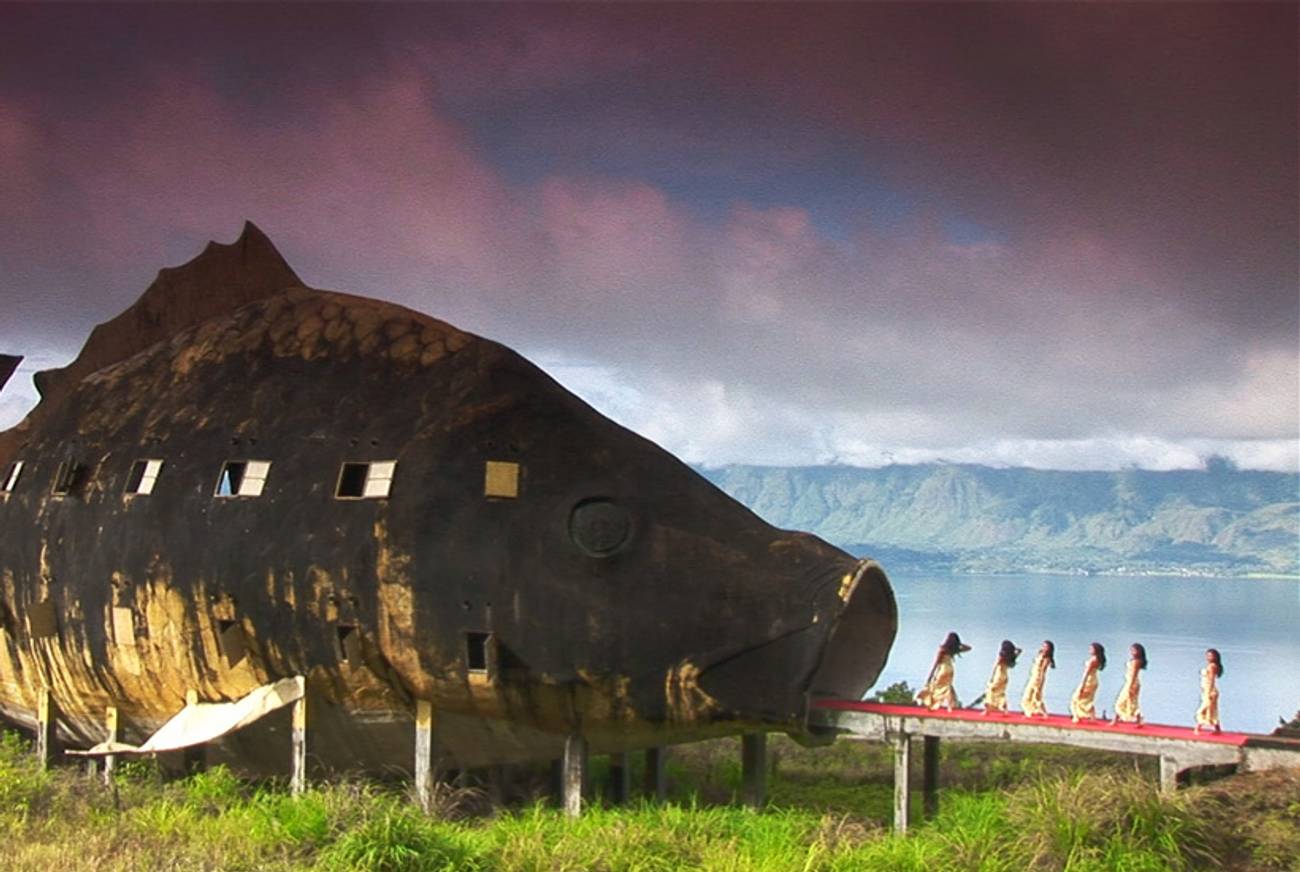Living the Nightmare of Mass Murder in Oscar-Nominated Doc The Act of Killing
Joshua Oppenheimer’s brutal film about the Indonesian genocide shows us what history looks like when blood-soaked sociopaths win




The title of Joshua Oppenheimer’s grotesque and provocative documentary The Act of Killing is a pun. The killers that Oppenheimer depicts, now elderly participants in the mid-1960s death-squad slaughter that brought the Suharto regime to power in Indonesia, are shown dramatizing their deeds for the camera—which is to say, they are putting on an act.
The Act of Killing is strong stuff. Small wonder that, having seen Oppenheimer’s footage, veteran documentary sensationalists Werner Herzog and Errol Morris signed on as executive producers. Oppenheimer’s movie could hardly be termed graphic in its depiction of atrocities. But once you grasp just what is being enacted on the screen, The Act of Killing becomes something like a candy-colored moral migraine. An existential nausea is inevitable.
Oppenheimer’s playful subjects several times restage, as farcical, fantastic, and sometimes musical entertainment, the murderous destruction of “communist” villages and simple murder of “communist” individuals, as part of a blood bath that took a million or more “communist” lives. (The magic word “communist” is a catch-all term that included not only members of Indonesia’s once large and legal, non-ruling Communist Party, but union members, landless farmers, intellectuals, ethnic Chinese, and miscellaneous supporters of Indonesia’s deposed strongman and influential Third World leader Sukarno.)
Indonesia’s coup was supported by the United States and other Western powers; that it is remembered here, if at all, is mainly due to Peter Weir’s 1982 movie The Year of Living Dangerously. That implanted cinematic memory is weirdly appropriate in that Oppenheimer’s two main subjects—the dapper, distinguished-looking senior citizen known as Anwar Congo and his overweight sidekick Herman Koto—were once petty criminals who made their living scalping movie tickets and, if they are to be believed, hated communists because they sought to ban Hollywood movies.
The two men were thus recruited into Suharto’s death squads, enabling them, says one, to “be more cruel than the movies.” Forty-odd years later, the former gangsters remain proud of their deeds, inanely hamming for the camera as they demonstrate their killing techniques, with Oppenheimer—off-screen, but often heard addressed and several times answering—as their horrified accomplice. Hanging with these unrepentant blood-soaked sociopaths, Oppenheimer—grandson of Jewish refugees from Nazi Germany—must have felt himself living in a nightmare alternate universe in which the Third Reich won World War II.
***
Now 39, the Texas-born, London-based filmmaker came to Indonesia in 2001, working with filmmaker Christine Cynn on The Globalization Tapes, a “participatory” documentary made with the Independent Plantation Workers Union of Sumatra. After learning something of Indonesia’s gory past, as well as the language, he devoted eight years to The Act of Killing—also participatory, if not in the way first intended.
Oppenheimer’s original subject was to be the coup’s victims or rather, the survivors. However, according to the filmmaker, official harassment was such that this approach turned out to be impossible as well as dangerous: “Not only did we feel unsafe filming the survivors. We worried for their safety.” Oppenheimer then pivoted to document those who could talk freely about the killings, namely the killers themselves. Suddenly, “all doors were open.” (Even so, many of the movie’s Indonesian participants, including Oppenheimer’s co-director, are prudently credited as Anonymous.)
The Act of Killing begins by quoting Voltaire’s Encyclopédie entry on “Rights”—“it is forbidden to kill; therefore all murderers are punished unless they kill in large numbers and to the sound of trumpets”—but also demonstrates the truism, attributed variously to Napoleon and Winston Churchill, that history is written by the victors. The movie was filmed mainly in Medan, the capital of North Sumatra and Indonesia’s fourth-largest city, where Anwar and even the clownish Herman are local heroes and figures of respect. Onlookers applaud Herman’s attempt to recruit elderly women to play “communist mothers” in one choreographed massacre; an even more gruesome scene staged out in the countryside elicits laughter from local spectators, many of whom are clapping (even as their terrified children cry).
Anwar, who is something of dandy, plays mainly to the camera, demonstrating the wire that he used to throttle his victims, estimated at one thousand. Afterward, he recalls, he got high and went out to dance the cha-cha. He and his cohorts were jazzed on movies: “We were killing … happily.” Overtly concerned with his image but not (at least initially) his deeds, Anwar watches Oppenheimer’s rushes on a TV monitor and critiques them, telling Oppenheimer that, in reality, he would never have worn white pants.
At one point, Herman poses for public office; Anwar meanwhile is running another sort of campaign. He repeatedly drags his young grandchildren on camera for hugs and kindly admonitions, at one point compelling one to apologize to a duck. At the same time, he pals around with his fellow butchers. One is a thuggish provincial governor who tells his beaming old comrade, “You’re a star now.” Another is a newspaper publisher who snappishly informs Oppenheimer that he was not a hands-on killer—there were always people to do the job for him. Anwar gets another old and respectable-looking former death-squad leader to appear in his movie—but only briefly. Not everyone is as keen as he to relive their youthful exploits.
Creating conditions wherein the vain and unwary might expose themselves, Oppenheimer is not unlike the cine-trickster Sacha Baron Cohen, although he would doubtless prefer a comparison to Claude Lanzmann, who badgered several old Nazis to revealing effect in Shoah. (Oppenheimer and I discussed Lanzmann’s film here.) At the same time, Oppenheimer’s evident and symbiotic fascination with Anwar pushes The Act of Killing toward psychodrama, if not actual therapy. Over the course of the movie, Anwar begins—however unwittingly—to, as a Freudian might say, work something out.
Unlike his stooge Herman, Anwar is a monster of some complexity. He admits to suffering from nightmares and, in addition to reenacting his exploits, wishes to dramatize these frightening dreams. These are fairly simple-minded, as when a threatening, garishly made up “communist” ghost emerges from a green fog to attack him. More complicated is the killer’s insistence in playing the victim in a number of dramatized scenes—proudly showing one, in which he is beaten and strangled, to his less-than-interested grandsons.
Late in the movie, Anwar goes so far as to tell Oppenheimer that, having played a victim in the movies, he can now feel empathy for the fear and suffering of the people he killed. Like a stern shrink, Oppenheimer (off-screen) can be heard telling his patient that the comparison is ludicrous. Yet, something is beginning to sink in. Oppenheimer does get Anwar to return once more to the actual crime scene—to startling effect. The killer has a prolonged involuntary and wholly appropriate physical reaction to his misdeeds—and in a way to the whole, lurid show.
“Why do people watch a film about Nazis,” Anwar at one point asks, before answering his own question: “To see power and sadism.” The Act of Killing asks, in effect, why victorious old Nazis might boast about their role in a genocide described by prime implementer Heinrich Himmler as “a glorious page in our history that has never been written and shall never be written.” The answer is, because they can. No need for the winners to keep a secret.
To watch Anwar and Herman’s jolly antics is to imagine the sort of nostalgic amateur movies that elderly veterans of the Wehrmacht or Einsatzgruppen could have made to celebrate their glory days. Indeed, The Act of Killing’s sense of derangement is accentuated by its sickeningly festive color schemes. The aqua blues, hot pinks, and canary yellows are more appropriate to an old-school Las Vegas floor show or a Pedro Almodóvar sex farce than a movie about a murder of monstrous proportions.
This tropical madness would seem to go with the territory. The members of the paramilitary Pancasila group that Anwar helped found repeatedly turn up wearing camouflage uniforms so gaudy in their iridescence they must have been designed to attract attention rather than conceal it. Why not show off? Herman is without qualms, although he does have definite ideas about motion pictures. “I like eye candy,” he declares, later adding that “humor is a must.” Perhaps playing a “communist woman,” Herman often appears in drag. Indeed, The Act of Killing reaches the outer limits of comedy in its biggest musical number, replete with costumed dancing girls and a giant carp, shot in a bucolic landscape by a waterfall and scored to the theme from Born Free. Feigning tears, Herman screeches his thanks to Anwar “for executing me and sending me to heaven.”
Appalling but, for me, The Act of Killing’s most revolting scene was in some ways its most quotidian one. Anwar and Herman are guests on the equivalent of an American daytime TV show, enthusiastically describing their movie in progress. The studio audience, full of uniformed Pancasila members, applauds as the perky, professionally excited woman conducting the interview breathlessly asks Anwar if his method of killing was cribbed from the gangster movies he watched. “Amazing!” she cries when he delightedly allows that it was. “He was inspired by films!” Then, in direct address to the camera, she explains that “Anwar and his friends developed a new, more efficient system for exterminating communists. It was more humane, less sadistic, and avoided excessive violence.”
Is her oh-wow enthusiasm real or feigned? (And which would be worse?) Smiling, gracious, resplendent in a Stetson hat and bolo tie, Anwar Congo basks in the glow of cathode-ray fame, a pop star come out of retirement to describe his greatest hits.
***
Like this article? Sign up for our Daily Digest to get Tablet Magazine’s new content in your inbox each morning.
J. Hoberman, the former longtime Village Voice film critic, is a monthly film columnist for Tablet Magazine. He is the author, co-author or editor of 12 books, including Bridge of Light: Yiddish Film Between Two Worlds and, with Jeffrey Shandler, Entertaining America: Jews, Movies, and Broadcasting.
J. Hoberman was the longtime Village Voice film critic. He is the author, co-author, or editor of 12 books, including Bridge of Light: Yiddish Film Between Two Worlds and, with Jeffrey Shandler, Entertaining America: Jews, Movies, and Broadcasting.